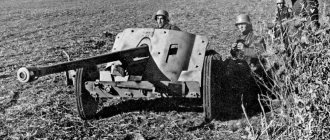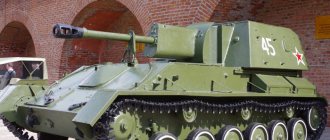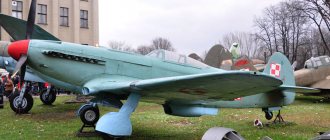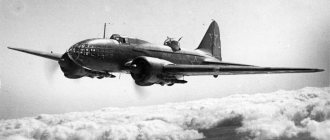During the Great Patriotic War, the actions of tank units played a huge role. To effectively counter tank fists, engineers developed and proposed guns of varying effectiveness. For the USSR, one of the most common and irreplaceable weapons in the initial period of the war was the 45-mm anti-tank gun. Modified in 1942, it walked the war roads with honor to Germany, and then managed to fight in Korea.
Despite many shortcomings and low penetration ability, it rightfully takes its place among the legends of artillery.
Creation of a cannon
In the 1930s, military theorists developed warfare tactics using armored vehicles. To counter tanks, artillery systems were needed that were light enough to be easily moved. Another requirement was to reduce power, no matter how strange it may sound. The gun had to effectively fight tanks and support infantry.
To simplify the work, the Soviet government in 1931 purchased drawings and prototypes of 37-mm guns produced by the German Rheinmetall. However, the caliber of the German gun seemed insufficiently powerful to the military, and a 45-mm barrel was placed on the carriage.
In 1937, it was time to modernize the gun. Ballistic characteristics were improved, a suspension system was introduced, but the main introduction was the installation of a semi-automatic bolt. The team at Plant No. 8 in the town of Podlipki, near Moscow, who were modernizing the gun, spent almost six months at the test site.
The new gun was tested by shooting and transportation.
The first point was assessed positively, the second gun almost failed, one of the springs was broken. Nevertheless, the changes to the new weapon affected almost every detail:
- semi-automatic began to work not only on armor-piercing, but also on fragmentation rounds due to the forced cocking of springs;
- a push-button release appeared;
- suspension, used for the first time on Soviet systems of this kind;
- wooden wheels were replaced with stamped metal ones, with rubber tires, produced by GAZ;
- the upper machine was made using the riveted-welded method, and not by casting, as before;
- the lower machine is also welded;
- the presence of a modernized rotary mechanism.
Military and factory tests in 1937 and 1938 revealed both the shortcomings and advantages of the new gun. As a result, the gun was put into service in 1938 with an overall rating of satisfactory, and at the same time it was put into mass production.
The 45-mm gun barely survived testing by Wehrmacht tanks. Effective against armored vehicles and early models of tanks, the “forty-five” was often powerless against the “threes” and “fours” of the Germans, not to mention the modernized tanks with reinforced armor that the Germans acquired after becoming familiar with the KV. The issue of strengthening the 45-mm gun was resolved in 1942, and the 1937 model was removed from service.
It is worth noting that the main reason for this “powerlessness” lay in defective shells supplied to the troops in the late 1930s.
The metal of the shells was highly overheated and became excessively hard and brittle, as a result of which the shells simply hit the armor of German tanks. At the same time, the fragmentation and shrapnel shells of the gun were characterized by rather low efficiency when firing at enemy personnel.
The 45-mm M-42 anti-tank gun, model 1942, designated GRAU 52-P-243S, also quickly became outdated. The modernization included increasing the length of the barrel, as well as the power of the charge in the shells. This improved the performance, but still the gun could not penetrate the latest German tanks.
However, the production of these guns was not stopped for several reasons. The main thing was the maneuverability of the gun, the ability to quickly move it with a crew of five people across the battlefield. The problem of low armor penetration was solved by ordering the crews to shoot at the sides and stern. The economic factor was also important, since the production of these guns was well established.
Gun design
The 45 mm gun consists of a carriage and a barrel with a bolt. The barrel is a monoblock, which already distinguishes it from earlier guns of the 37-40s, which had composite, bonded barrels. The bolt is a wedge type, which ensures a high rate of fire, up to 15 rounds per minute with a trained crew.
Of particular interest is the mechanical sight, which was installed on a number of guns; with it, the gun could fire a direct shot even with a broken panorama.
The carriage is of the classic type, with a sprung rubber run. It consists of a cradle, an upper machine with guidance devices, a lower one with tubular-shaped thrust frames, welded coulters, and places on the frames for attaching spare parts. The lower machine has a rotation angle of up to 60 degrees horizontally.
The gun weighs 625 kg in combat position; during travel, the weight increases to 1250 kg. The dimensions of the gun are small, with a height of 1300 mm, its length is 4885 mm, and its width is 1634 mm. Ground clearance of 275 mm provides good opportunities for movement on the battlefield and in the rear.
Ammunition was presented in several types:
- 53-B-240, armor-piercing blunt-headed projectile, chamber type, TNT charge 0.019 kg;
- 53-BR-240 and 53-BR-240SP, armor-piercing tracer round, SP-solid;
- armor-piercing tracer (solid), new release shells;
- 53-BR-240P sub-caliber coil for a 45 mm shot, had a relatively small distribution;
- 53-O-240 and 53-O-240A fragmentation modifications, A - with a body made of steel cast iron;
- 53-Shch-240, shrapnel shell, the charge consisted of metal buckshot in a cardboard tube;
- A 53-D-240 smoke corrective projectile produced a clearly visible cloud of smoke at the explosion site.
The presented ammunition ensured that the tasks assigned to the crews were completed at a high level, which is confirmed by reports on their use on the battlefield, despite the small caliber of the gun and its overall low effectiveness against heavy tanks.
What's the end result?
As mentioned above, to replace the 45-mm guns mod. 1932 and 1937 a new “forty-five” was created. The design of the gun has not changed much. The barrel was lengthened to 68.8 cal, the charge in the cartridge case was increased. The initial velocity of the projectile increased from 760 to 870 m/s, and accordingly, armor penetration increased. But by that time, the Wehrmacht already had completely different tanks in service, against which the new “forty-fives” were powerless. In addition, as Andrei Ulanov writes in his article “Forty-five, boring and irreplaceable,” the new gun retained all the numerous operational shortcomings of the previous design.
The Forty-Five, for all its shortcomings, became a very useful weapon. But not so much as an anti-tank weapon, but as a battalion one. The 500-kilogram cannon was easily transported to the battlefield by crews and accompanied infantry. And there were many targets for it, even in the complete absence of tanks - these were firing points, machine gun nests, bunkers. "Forty-five" turned into the main weapon of guerrilla warfare, even more common than mortars. Moreover, they were used not only by the partisans, but also by those who fought against them.
Combat use of the gun
The Sorokopyatka had many advantages over other guns, the main one of which front-line artillerymen call stealth. Ambushes and camouflaged positions were often “surprises” for the Germans, and effective fire made it possible to repel attacks by superior enemy forces. In 1942, according to the order of the People's Commissariat of Defense, artillery of this caliber was reduced to the legendary anti-tank destroyer units.
The personnel of these units were subject to special registration; in case of injury, they returned to duty only to their units. Officers, sergeants and privates received increased rations, increased pay, as well as bonus payments for damaged equipment.
The distinctive sign of such artillerymen is a black diamond sleeve with crossed gun barrels. According to recollections, when a PTA officer entered the canteen, everyone present stood up.
The saturation of the Soviet army with anti-tank artillery horrified the Germans.
Constant hits on tank hulls and damage to the chassis kept the crews out of their psychological balance. So, one of the German tank crews will say after the Battle of Kursk that every Soviet infantryman had a cannon in his pocket.
A major role was played by the support of the “forty-five” crews to the advancing infantry. In urban combat conditions, this light and maneuverable weapon made it possible to support attacking groups without unnecessary preparation. The ability to fire buckshot and fragmentation shells added to the infantry’s love for the cannon.
After the end of the war, the cannon was discontinued as it was replaced by new, more powerful guns. But the career of the 45 mm gun did not end there. The conflict on the Korean Peninsula, in which the USSR decided not to officially intervene, was generously supplied by both the American and Soviet sides.
The North Korean army received many types of equipment that went through the Great Patriotic War, including the 45-mm M-42 gun.
It was especially loved by Korean comrades for the above positive features. The Americans carefully studied the seemingly outdated captured guns. Cases of using trophies in battles have been recorded.
In different capacities
The 45-mm guns had several modifications: the first was of the 1932 model, under the factory designation 19-K; then it was improved - a version of the 1937 model, index 53-K. 49,074 such guns were manufactured, including 16,621 before the war.
In 1942, a new model under the symbol M-42 saw the light: 10,843 units were produced before the end of the war.
A. Shirokorad, in his Encyclopedia of Russian Artillery, mentions the existence of a mountain-type cannon, which could be disassembled into parts and transported in this form on pack animals.
In addition, there was also a tank version, designated 20-K. It was produced until the end of the war and was installed on tanks and armored vehicles. A total of 32,453 tank guns were produced.
There was also a casemate version of the gun for installing DOT-4. Before the war, they managed to produce 410 such installations.
Since Plant No. 8 could not provide the army and navy with small-caliber anti-aircraft artillery, an anti-aircraft (or rather, universal) version of the 45-mm gun under the symbol 21-K was designed. The gun was created (also in the Sharashka) in 1932, but it was practically no different from the Hotchkiss 47-mm naval guns of the late 19th century. In the absence of modern guns, the production of which Plant No. 8 under the leadership of M. N. Loginov could not master, 4,009 such guns were produced, and they were used on ships and in coastal defense.
Trace in culture
The weapon in question, despite its low efficiency, was popular and beloved among the troops. The love of the infantry, the most massive branch of the military, was transferred to the common population. “Magpie” can be found on the pages of books and seen in films. At the same time, even in high-quality films, more modern ZIS-3 guns are often passed off as 45 mm guns. Not a single game reflecting events on the battlefields of the Great Patriotic War can do without this weapon.
Having gone through the entire war and undergoing modernization, this gun continued to remain the best friend of the infantry, both in defense and in the offensive.











